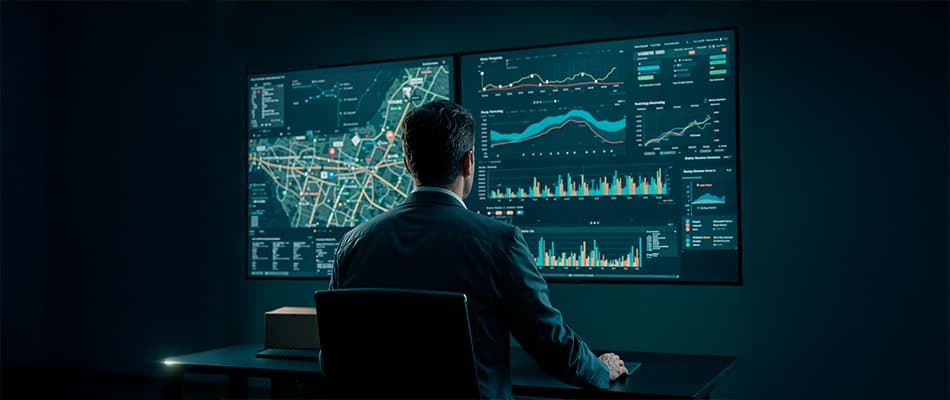What are the Advantages of a Graphical User Interface?- Know Its Usefulness in Modern Technology!
A Graphical User Interface (GUI) is a way for users to interact with electronic devices through visual elements. It includes items like icons, buttons, menus, and windows. GUIs make it easier for users to manage and control software or hardware without using text commands.
Designed with the average user in mind, GUIs allow people to interact with devices using graphical elements like buttons, menus, windows, and icons. These interfaces made computers and other devices easier to use by allowing direct manipulation through tools like a mouse or touchscreen. Today, GUIs also support voice commands, adding further convenience to user interactions.
Read the article to know what are the advantages of a graphical user interface, its different applications and how it improves user experience.
What is a Graphical User Interface (GUI)?
A Graphical User Interface (GUI) is a system that allows you to interact with your device using visual elements like buttons, icons, and windows instead of typing commands. It makes using computers, smartphones, tablets, and other devices much easier. You can click on images or menus with a GUI to perform tasks.
GUIs are used in apps, web browsing, and games. They are also used by website builders to create websites easily. By providing a visual way to interact, GUIs make devices more user-friendly and accessible, even for those without technical knowledge. GUIs are an essential part of modern technology.
Learn more about graphic design salary cape town here

What are the Advantages of a Graphical User Interface?
Graphical User Interfaces (GUIs) simplify how people interact with technology. They make devices more accessible using visuals like icons, buttons, and menus. GUIs improve user experience by being visually appealing, intuitive, and easy to customise.
They help reduce errors and improve efficiency with clear feedback and practical tools. Their design supports multitasking and ensures consistency across different platforms, making them a popular choice for both personal and professional use. Let us know the advantages of a graphical user interface below:
- Ease of Use: GUIs make technology user-friendly with clear visual elements like icons and buttons. Through intuitive design, users can quickly learn how to interact with devices and software, reducing the need for extensive instructions or training.
- Visual Appeal: The design of GUIs is attractive and engaging, using colours, icons, and animations that make interacting with technology enjoyable. A visually appealing interface can draw users in and make them more likely to continue using the software or device.
- Accessibility: GUIs are created with simplicity in mind, making them accessible even to beginners or individuals with limited technical skills. Easy-to-understand icons and straightforward navigation help users understand how to operate the interface with little effort.
- Improved Efficiency: GUIs streamline processes and speed up tasks by providing tools such as shortcuts, menus, and toolbars. These features allow users to perform tasks quickly and seamlessly, leading to increased productivity.
- Error Reduction: GUIs help minimise user errors by offering helpful feedback and warning messages. For example, if a user skips filling out a required field, it is highlighted to alert them, reducing the chance of mistakes and improving accuracy.
- Customisation and Flexibility: GUIs can be personalised according to user preferences. This includes adjusting themes, settings, or layouts to create a more comfortable and better experience. Customisation options, such as switching to dark mode or changing font sizes, improve usability for individual needs.
Know What Technical & Soft Skills Do I Need To Be A Graphic Designer?
Applications of GUI
If you are wondering what are the advantages of a graphical user interface, there are several, including its applications. GUI applications are used in various fields, which makes technology accessible and user-friendly. They provide visual elements like icons, menus, and buttons to simplify interactions. GUIs support different skill levels for users to ensure effective and easy interaction.
From personal devices to industrial systems, GUIs improve usability and functionality in every system. Their flexibility has made them integral to modern technology, offering smooth experiences across platforms. Below are key areas where GUIs are widely used.
- Personal Computing: GUIs make operating systems like Windows or macOS easy to navigate. Productivity software, such as word processors or spreadsheets, also relies on GUIs for smooth user interaction.
- Mobile Devices: Smartphones and tablets use GUIs to make navigation simple and intuitive. Touchscreen gestures, like swiping and tapping, are central to the mobile experience.
- Web Interfaces: Websites and online tools use GUIs to make browsing and tasks more user-friendly. Buttons, icons, and navigation bars help users easily interact with content.
- Gaming: GUIs in games provide interactive menus for options, settings, and controls. These visual interfaces enhance the gaming experience by being easy to use and engaging.
- Industrial Systems: In industrial settings, GUIs are used in control panels to monitor and manage machinery. They allow operators to interact with complex systems through clear visual displays.

How GUIs Improve User Experience
Once you know what are the advantages of a graphical user interface, it woud be easier for you to understand GUI improve user experience. Graphical User Interfaces (GUIs) focus on design elements to make interaction easier and improve user experience. They prioritise simplicity, offer clear navigation, and engage users visually.
GUIs are designed to provide immediate feedback, enhance productivity, and ensure users feel in control while using a system, all of which contribute to an overall positive experience. Let us know how GUI improve user experience below:
- User-Centric Design: GUIs are designed with the user’s needs in mind, ensuring they are easy to understand and use. Simplicity and clarity in design help users navigate the system effortlessly.
- Interactive Feedback: GUIs provide visual cues, like buttons changing colour or loading indicators, to let users know their actions are being processed. This immediate feedback helps users feel more confident while interacting with the system.
- Engagement: Visually appealing elements, such as animations and attractive icons, create a more engaging experience. This keeps users interested, encouraging them to stay longer and interact more with the product.
Learn Graphic Design with Digital Regenesys
If you are ready to begin your journey in graphic design, you can consider Digital Regenesys’s UI/UX and Graphic Design with Gen AI Course. Here, you’ll learn the art of design through hands-on practice and expert-led sessions using tools like Adobe, Canva, and Figma.
The course also explores Generative AI to upskill your creative potential. Let us know the reasons to consider Digital Regenesys’s UI/UX and Graphic Design with GenAI Course below:
- Learn both UI/UX design and graphic design skills.
- Learn to create user-friendly and visually appealing digital products.
- Gain hands-on experience with industry-leading tools like Figma, Adobe, and Canva.
- Access live sessions from industry experts.
- Get career guidance and support.
- Obtain globally recognised certificates.
- Learn to use generative AI in design.
- Build proficiency in front-end development basics.
- Access to flexible online classes from anywhere.
In conclusion, understanding the advantages of a graphical user interface (GUI) is essential in the modern tech world. GUIs simplify interactions, improve accessibility, and boost efficiency, supporting multitasking and customisation for consistency across platforms. They have revolutionised how we use technology, from personal computing to industrial systems. Digital Regenesys’s UI/UX and Graphic Design with GenAI Course builds on these principles, equipping you with the skills to create user-friendly, visually appealing digital products. This course improves your design potential with Generative AI, preparing you to meet the evolving demands of UI/UX design.

FAQs on What are the Advantages of a Graphical User Interface
What is a graphical user interface (GUI)?
A GUI is a system that allows users to interact with devices through visual elements like buttons, icons, and windows instead of typing commands.
How does a GUI improve user experience?
GUIs make devices easier to use by providing intuitive design, clear feedback, and engaging visuals, enhancing user control and productivity.
What are the advantages of a graphical user interface?
GUIs simplify interactions, improve accessibility, reduce errors, increase efficiency, support multitasking, and allow customisation.
Where are GUIs commonly used?
GUIs are widely used in personal computers, mobile devices, gaming, web interfaces, and industrial systems for easy interaction.
What are the key features of a GUI?
Key features include icons, buttons, menus, windows, and feedback elements designed to make user interaction seamless and visually engaging.
How can Digital Regenesys’s course help with GUI design?
Digital Regenesys’s UI/UX and Graphic Design with GenAI Course teaches you to design user-friendly digital products and improves your skills in design tools and generative AI.














